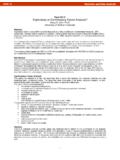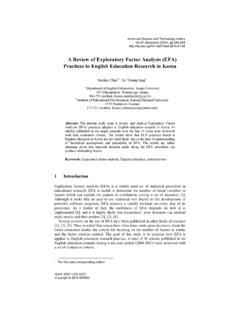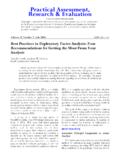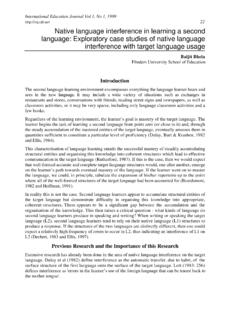Transcription of Exploratory Factor Analysis with R - Statpower
1 Exploratory Factor Analysis with R James H. Steiger Exploratory Factor Analysis with R can be performed using the factanal function. In addition to this standard function, some additional facilities are provided by the function written by Dirk Enzmann, the psych library from William Revelle, and the Steiger R Library functions. To investigate some of the capabilities of these functions and work through this handout, please set up your working directory (either through the menu system or using the setwd command). setwd("C:/!!!Current Projects/P312/2009/R Working/ Factor Analysis /") Then download the extra functions from the R Support Materials page at the course website and load them in with the commands: source(" ") source("Steiger R Library ") Make sure that the Hmisc library is installed on your computer and has been loaded, as follows.
2 If you are in the Hobbs 107 lab, you will need to remember how to set up a local library directory. Once the directory exists, you can enable it with the command .libPaths( c:/MyRLibs ) Otherwise, you can simply install and load the package with the commands (Hmisc) library(Hmisc) Once the library is loaded, you can load the AthleticsData file and attach it with the commands AthleticsData <- (" ") attach(AthleticsData) has changed the variable names slightly, as you can see by calling the names function. names(AthleticsData) [1] "PINBALL" "BILLIARD" "GOLF" " " " " " " [7] "BENCH" "CURL" "MAXPUSHU" Common Factor Extraction and Rotation with factanal As mentioned in class, there are in wide use two primary approaches to Factor analytic methods: (a) common Factor Analysis , and (b) component Analysis . In this section, we discuss the common Factor model.
3 The common Factor model is a very restrictive model. It never fits perfectly in the sample (unless the sample is one we have constructed to fit perfectly!), and so we fit the common Factor model in practice by making the discrepancy between the sample covariance matrix and the reproduced matrix as small as possible, according to a criterion known as a discrepancy function. Specifically, the orthogonal common Factor model implies that 2 =+FFUS ( ) Of course, we don t know S, and because of sampling error, even if the common Factor model fit S perfectly, it would not fit the sample covariance matrix S perfectly. In practice then, we have 2 =++=+SFFU EES ( ) where E is made as small as possible according to some criterion.
4 This criterion is a function of S and S, and reflects the size of the discrepancy between them. There are a number of discrepancy functions in use. Perhaps the most popular is the maximum likelihood (ML) discrepancy function. When F and U are chosen to minimize the ML discrepancy function, they are referred to as maximum likelihood estimates. Maximum likelihood estimates are obtained by iteration, a process in which F and U are systematically altered to make the maximum likelihood discrepancy function get smaller and smaller. As discussed in the handout on The Algebra of Factor Analysis , for any F in Equation ( ), there are infinitely many alternative Factor patterns that fit equally well. These are obtainable by orthogonal or oblique transformation. The process of transforming a Factor pattern is generally referred to as rotation.
5 There are many methods of rotation. Two very popular methods are varimax rotation for orthogonal factors and promax rotation for oblique factors . Both methods are implemented in R. The factanal function fits a common Factor model by the method of maximum likelihood. You can find out a bit about the function through the R help system. Note: the function can analyze either raw data or a correlation or covariance matrix. To begin with, let s analyze the AthleticsData with a 2 Factor model. > <- factanal(AthleticsData, factors =2,rotation="varimax") > print( ) Call: factanal(x = AthleticsData, factors = 2, rotation = "varimax") Uniquenesses: PINBALL BILLIARD GOLF BENCH CURL MAXPUSHU Loadings: Factor1 Factor2 PINBALL BILLIARD GOLF BENCH CURL MAXPUSHU Factor1 Factor2 SS loadings Proportion Var Cumulative Var Test of the hypothesis that 2 factors are sufficient.
6 The chi square statistic is on 19 degrees of freedom. The p-value is Near the bottom of the output, we can see that the significance level of the 2c fit statistic is very small. This indicates that the hypothesis of perfect model fit is rejected. Since we are in a purely Exploratory vein, let s fit a 3 Factor model. > <- factanal(AthleticsData, factors =3,rotation="varimax") > print( ) Call: factanal(x = AthleticsData, factors = 3, rotation = "varimax") Uniquenesses: PINBALL BILLIARD GOLF BENCH CURL MAXPUSHU Loadings: Factor1 Factor2 Factor3 PINBALL BILLIARD GOLF BENCH CURL MAXPUSHU Factor1 Factor2 Factor3 SS loadings Proportion Var Cumulative Var Test of the hypothesis that 3 factors are sufficient.
7 The chi square statistic is on 12 degrees of freedom. The p-value is These results are much more promising. Although the sample size is reasonably large, 1000N=, the significance level of .373 indicates that the hypothesis of perfect fit cannot be rejected. Changing from two factors to three has produced a huge improvement. We can clean up the Factor pattern in several ways. One way is to hide small loadings, to reduce the visual clutter in the Factor pattern. Another is to reduce the number of decimal places from 3 to 2. A third way is to sort the loadings to make the simple structure more obvious. The following command does all three. print( , digits = 2, cutoff = .2, sort = TRUE) Call: factanal(x = AthleticsData, factors = 3, rotation = "varimax") Uniquenesses: PINBALL BILLIARD GOLF BENCH CURL MAXPUSHU Loadings: Factor1 Factor2 Factor3 BENCH CURL MAXPUSHU PINBALL BILLIARD GOLF Factor1 Factor2 Factor3 SS loadings Proportion Var Cumulative Var Test of the hypothesis that 3 factors are sufficient.
8 The chi square statistic is on 12 degrees of freedom. The p-value is Now it is obvious that there are 3 factors . The traditional approach to naming factors is as follows: Examine the variables that load heavily on the Factor Try do decide what construct is common to these variables Name the Factor after that construct It seems that there are three factors . The first Factor is something that is common to strong performance in a 1500 meter run, a 2000 meter row, and a 12 minute run. It seems like a good name for this Factor is Endurance. The other two factors might be named Strength, and Hand-Eye Coordination. We can add these names to the loading matrix as follows: > colnames( $loadings)<-c("Endurance","Strength","Hand-Eye") > print(loadings( ), digits = 2, cutoff = .2, sort = TRUE) Loadings: Endurance Strength Hand-Eye BENCH CURL MAXPUSHU PINBALL BILLIARD GOLF Endurance Strength Hand-Eye SS loadings Proportion Var Cumulative Var You can obtain an oblique promax solution by using the option rotation = promax.
9 <- update( ,rotation="promax") colnames( $loadings)<-c("Endurance","Strength","Hand-Eye") print(loadings( ), digits = 2, cutoff = .2, sort = TRUE) Loadings: Endurance Strength Hand-Eye BENCH CURL PINBALL BILLIARD GOLF MAXPUSHU For more information about the rotation methods, consult the R help with the command ?varimax. Enzmann s Enhanced Function Dirk Enzmann has made an enhanced version of the factanal function available online. This function will compute and save a number of key quantities in its fit object. In particular, it automatically computes unrotated, varimax rotated, and promax rotated solutions, as well as the Factor correlation matrix.
10 With Enzmann s function and some of the Factor Analysis utilities we have provided, many other interesting quantities can be computed. Let s take a quick look at some input and output from To enhance the output with Factor names, use the following function. AssignFactorNames <- function( ,names) { colnames( $ )<-names colnames( $ )<-names rownames( $ )<-names colnames( $ )<-names } Here is a Factor Analysis of our AthleticsData file. The cutoff function does not work. <- (AthleticsData, factors =3, digits=2, sort=TRUE) AssignFactorNames( , ) $uniqueness residual variance BENCH BILLIARD GOLF CURL MAXPUSHU PINBALL $ Factor1 Factor2 Factor3 BENCH CURL MAXPUSHU BILLIARD GOLF PINBALL $ Factor1 Factor2 Factor3 SS loadings Proportion Var Cumulative Var $ Factor1 Factor2 Factor3 BENCH CURL MAXPUSHU BILLIARD GOLF PINBALL









